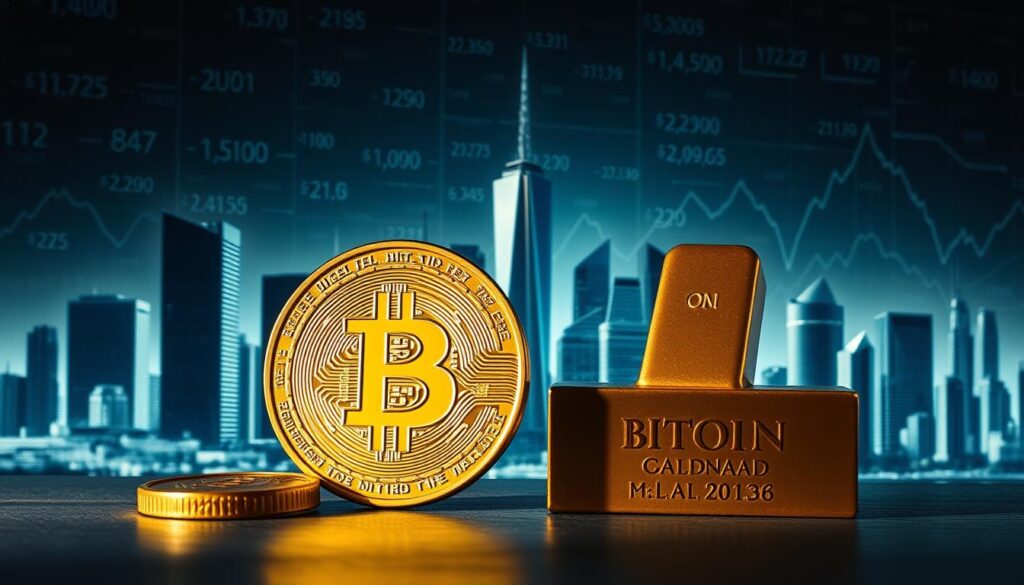Imagine a world where traditional currencies vanish overnight, replaced entirely by decentralized digital assets. This radical idea, first theorized by Daniel Krawisz in 2014, suggests societies might voluntarily abandon weaker monetary systems for more efficient alternatives. Krawisz’s concept describes a rapid, irreversible shift that could redefine how value is stored and exchanged globally.
At its core, this transformation hinges on perceived superiority. Just as hyperinflation destroys trust in unstable currencies, technological advancements and economic pressures could drive mass adoption of alternative systems. Krawisz argued the process would accelerate once critical thresholds of utility and acceptance are reached.
Today’s financial landscape reveals growing interest in non-state-backed assets. While adoption rates vary globally, innovations in blockchain technology and shifting public sentiment create fertile ground for change. The real question isn’t about possibility but practicality—can decentralized networks overcome regulatory hurdles and scalability challenges?
Economic experts remain divided. Some see parallels with historic monetary transitions, where superior tools naturally displaced outdated models. Others caution that systemic complexity and entrenched power structures might stall progress indefinitely. The debate continues as new data emerges from early-adopting communities.
Key Takeaways
- Daniel Krawisz’s 2014 theory predicts rapid, irreversible adoption of superior monetary systems
- Compares economic transformation mechanics to hyperinflation dynamics
- Global adoption depends on technological readiness and public trust
- Could redefine core financial concepts like value storage and exchange methods
- Current adoption patterns suggest gradual growth rather than sudden displacement
Understanding Hyperbitcoinization: Definitions and Core Concepts
What drives societies to abandon established currencies for new alternatives? History shows monetary systems evolve when innovation meets necessity. This section unpacks the mechanics behind such transformations and their modern implications.
Historical Context and Evolution
Monetary shifts follow patterns. Ancient civilizations moved from barter to precious metals, then to paper notes. Each transition solved specific problems—portability, divisibility, or centralized control.
The 20th century saw fiat currencies dominate through government decree. Today, decentralized networks challenge this model. Austrian economics principles suggest superior systems naturally attract users through utility, not force.
Key Definitions and Terminology
Three concepts shape this discussion:
- Currency substitution: When populations adopt foreign or digital assets during local instability
- Reverse Gresham’s Law: Better-designed money pushes inferior options out of circulation
- Network effects: Adoption accelerates as more participants join the system
Unlike hyperinflation crises, this transition involves voluntary adoption of advanced technology. Analysts note parallels with 1990s dollarization in Latin America, but with a crucial difference—the replacement asset operates outside traditional power structures.
The Genesis of Hyperbitcoinization in Modern Economic Thought

How do revolutionary financial ideas take root? In 2014, an unconventional framework emerged that reimagined currency transitions through digital innovation. This thinking blended historical economic patterns with emerging technological realities.
Daniel Krawisz’s Early Speculation on Digital Assets
An Austrian economics enthusiast first mapped this radical transition concept. He envisioned a scenario where technological superiority, not government mandate, drives currency replacement. His 2014 analysis predicted exponential adoption curves mirroring hyperinflation patterns but with constructive outcomes.
The theory suggested societies might experience growing pains comparable to adolescence. During this adjustment period, people would relearn how to store value and conduct transactions. “It becomes irreversible once critical mass is achieved,” he noted, emphasizing voluntary adoption over forced compliance.
From Currency Collapse to System Evolution
Traditional inflation crises destroy purchasing power. The new model flips this narrative—instead of collapse, it proposes organic upgrades. Network effects create self-reinforcing cycles where each new user increases the system’s utility.
Modern analysts build on these foundations using game theory. When rational actors choose efficiency over familiarity, entire economies can shift. This mirrors historical transitions from barter to metal coins, but accelerated by digital connectivity.
Current research explores how time affects adoption rates. Early movers face uncertainty, while late adopters benefit from established infrastructure. The process challenges conventional views about how economies evolve in the digital age.
hyperbitcoinization, Bitcoin standard, monetary theory, future of money

What separates enduring stores of value from temporary solutions? History reveals scarcity as the critical factor. Precious metals dominated for millennia because their limited supply resisted devaluation. Today’s digital equivalent introduces programmable rarity through cryptographic design.
The proposed framework positions absolute scarcity as its cornerstone. With a predetermined cap mimicking time’s unyielding nature, this system creates mathematically enforced discipline. Unlike gold mining discoveries or paper currency printing, no centralized authority can alter its fundamental rules.
This approach solves historical challenges faced by physical assets. Digital verification replaces cumbersome purity tests. Global transfers occur instantly rather than through guarded caravans. The architecture enables individual sovereignty over wealth preservation that physical bullion couldn’t guarantee.
Economic models show how fixed-supply systems reshape financial behavior. When savings can’t be eroded through inflation, capital allocation becomes purpose-driven. Investors prioritize long-term projects over speculative trading. This shift could stabilize markets historically shaken by artificial liquidity injections.
Network growth amplifies these effects. Early adopters face volatility, but each new participant strengthens infrastructure. Payment processors and custodial services emerge organically, mirroring gold’s historical financial ecosystem evolution. The difference lies in execution speed – years instead of centuries.
Short-Term Impacts: Transitioning from Fiat Currency to Bitcoin
The first wave of currency transformation is already underway across the globe. Twelve years after digital assets entered mainstream consciousness, nations are testing uncharted economic waters. This shift introduces novel substitution models where traditional systems face unprecedented competition.
Initial Global Country Adoptions
Smaller economies with volatile money supplies lead this transition. Nations like El Salvador demonstrate how adopting alternative systems can stabilize purchasing power. These early adopters gain trade advantages while protecting citizens from inflation.
Governments facing monetary crises find lower risks in radical changes. “When your currency fails, you try anything that works,” notes a Caribbean central bank advisor. This creates a domino effect as neighboring countries observe successful implementations.
Emergence of New Currency Substitution Models
Traditional dollarization pales against modern alternatives. Instead of relying on foreign fiat, countries now explore neutral digital standards. Parallel systems emerge where old and new currencies coexist during transitions.
People in adopting nations immediately benefit from preserved wealth. Meanwhile, governments maintaining outdated systems face growing pressure. This dynamic reshapes international trade relationships and monetary policies.
Long-Term Effects on Monetary Policy and Economic Stability

Economic foundations could experience seismic shifts under new financial paradigms. Fixed-supply systems challenge centuries of inflationary practices, potentially rewriting rules for institutions and consumers alike.
Ending Perpetual Inflation
Traditional systems require constant money creation. This leads to rising prices despite technological progress lowering production costs. A capped supply reverses this dynamic through growth deflation.
| Factor | Fiat System | Fixed Supply |
|---|---|---|
| Money Creation | Unlimited | Predefined Cap |
| Price Trend | Upward | Downward |
| Savings Impact | Erodes Value | Preserves Value |
Without central bank interventions, interest rates reflect real market conditions. This eliminates artificial credit bubbles that distort the economy.
Shifts in Investment and Asset Valuation
Assets would shed their inflation-hedge premiums. Real estate and commodities would be valued for utility rather than scarcity narratives.
| Asset Class | Current Driver | Future Driver |
|---|---|---|
| Housing | Speculation | Housing Needs |
| Stocks | Easy Money | Earnings Growth |
| Gold | Fear | Industrial Use |
Market-determined rates would redirect capital to productive ventures. “Savings become the true engine of growth,” observes a Federal Reserve researcher. This shift could reduce boom-bust cycles by 70% within decades.
Comparing Bitcoin Standard with Traditional Gold and Fiat Systems
The evolution of monetary systems reflects humanity’s quest for stability and efficiency. Physical commodities and government-issued notes each brought unique strengths—until their limitations sparked new innovations.
Modern Cryptographic Systems vs Precious Metals
Gold’s physical nature created logistical challenges. Moving bullion required armored transport, while verifying purity demanded expert assessment. These constraints led to centralized storage in bank vaults, enabling eventual replacement by paper alternatives.
New cryptographic networks solve these historical pain points. Instant global transfers eliminate shipping delays. Digital verification replaces manual inspection processes. Unlike physical assets, these systems resist seizure through decentralized control structures.
Patterns from Failed Monetary Experiments
History shows fiat currencies typically collapse within generations. The Roman denarius and Weimar mark both succumbed to mismanagement. Modern paper systems face similar risks—97% eventually fail through devaluation or replacement.
Precious metals lasted longer but couldn’t scale. The classical gold standard collapsed when war demands exceeded physical supplies. Today’s digital equivalents avoid this trap through predetermined scarcity models, merging gold’s endurance with digital practicality.
FAQ
How does hyperbitcoinization differ from hyperinflation?
Hyperinflation occurs when fiat currencies rapidly lose value due to excessive money printing, while hyperbitcoinization describes a scenario where decentralized digital assets like Bitcoin replace government-issued money as the dominant medium of exchange. The former reflects systemic failure, while the latter represents voluntary adoption driven by superior utility.
Can a Bitcoin standard coexist with existing fiat systems?
In the short term, parallel systems may emerge as nations like El Salvador adopt crypto as legal tender. However, long-term coexistence is unlikely if decentralized networks offer greater stability, censorship resistance, and predictable scarcity compared to inflation-prone fiat currencies controlled by central banks.
What historical precedents support the viability of a Bitcoin standard?
The gold standard maintained relative price stability for centuries before governments abandoned it for flexible fiat regimes. Bitcoin’s fixed supply and decentralized governance mirror gold’s scarcity but add programmability and borderless transfer capabilities, addressing historical limitations of commodity-based money.
How would hyperbitcoinization impact everyday financial transactions?
Transitioning to blockchain-based systems could reduce fees, settlement times, and reliance on intermediaries. Smart contracts might automate payments, while self-custody wallets empower users. However, volatility during early adoption phases could challenge pricing consistency for goods and services.
What risks emerge if central banks lose monetary control?
Governments may resist ceding power over money creation, leading to regulatory clashes. Sudden shifts could destabilize debt markets reliant on inflation. Conversely, removing centralized control might reduce boom-bust cycles driven by artificial credit expansion and interest rate manipulation.
Does Bitcoin’s energy consumption hinder its adoption as global money?
Proof-of-work mining secures the network but requires significant energy. Critics argue this is unsustainable, while proponents highlight increasing renewable energy use and compare its efficiency to traditional banking infrastructure. Technological innovations may further optimize resource usage over time.
How might hyperbitcoinization affect wealth distribution globally?
Early adopters could gain disproportionate influence, similar to landholders during agrarian reforms. However, open access to decentralized networks might democratize financial services for unbanked populations, potentially reducing inequality if adoption spreads equitably across socioeconomic groups.


